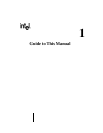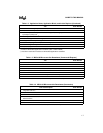
8XC196MC, MD, MH USER’S MANUAL
1-2
Chapter 9 — Waveform Generator — describes the waveform generator and explains how to
configure it. For additional information and application examples, consult AP-483, Application
Examples Using the 8XC196MC/MD Microcontroller (order number 272282).
Chapter 10 — Pulse-width Modulator — provides a functional overview of the pulse width
modulator (PWM) modules, describes how to program them, and provides sample circuitry for
converting the PWM outputs to analog signals.
Chapter 11 — Event Processor Array (EPA) — describes the event processor array, a tim-
er/counter-based, high-speed input/output unit. It describes the timer/counters and explains how
to program the EPA and how to use the EPA to produce pulse-width modulated (PWM) outputs.
Chapter 12 — Analog-to-digital (A/D) Converter — provides an overview of the analog-to-
digital (A/D) converter and describes how to program the converter, read the conversion results,
and interface with external circuitry.
Chapter 13 — Minimum Hardware Considerations — describes options for providing the ba-
sic requirements for device operation within a system, discusses other hardware considerations,
and describes device reset options.
Chapter 14 — Special Operating Modes — provides an overview of the idle, powerdown,
and on-circuit emulation (ONCE) modes and describes how to enter and exit each mode.
Chapter 15 — Interfacing with External Memory — lists the external memory signals and de-
scribes the registers that control the external memory interface. It discusses the bus width and
memory configurations, the bus-hold protocol, write-control modes, and internal wait states and
ready control. Finally, it provides timing information for the system bus.
Chapter 16 — Programming the Nonvolatile Memory — provides recommended circuits, the
corresponding memory maps, and flow diagrams. It also provides procedures for auto program-
ming.
Appendix A — Instruction Set Reference — provides reference information for the instruction
set. It describes each instruction; defines the processor status word (PSW) flags; shows the rela-
tionships between instructions and PSW flags; and lists hexadecimal opcodes, instruction
lengths, and execution times. (For additional information about the instruction set, see Chapter 3,
“Programming Considerations.”)
Appendix B — Signal Descriptions — provides reference information for the device pins, in-
cluding descriptions of the pin functions, reset status of the I/O and control pins, and package pin
assignments.


















